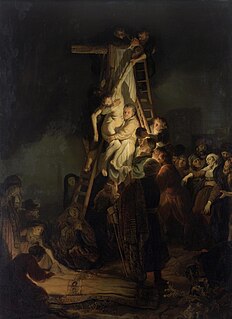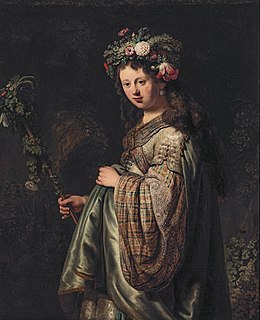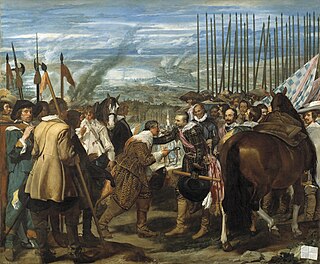 W
WThe Adoration of the Golden Calf is a painting by Nicolas Poussin, produced between 1633 and 1634. It depicts the adoration of the golden calf by the Israelites, from chapter 32 of the Book of Exodus. It was made as part of a pair of paintings commissioned by Amadeo dal Pozzo, Marchese di Voghera of Turin, a cousin to Cassiano dal Pozzo, Poussin's main sponsor in Rome. By 1685 the pair had passed to the Chevalier de Lorraine and in 1710 they were bought by Benigne de Ragois de Bretonvillers. In 1741 they were bought from Samuel by Sir Jacob Bouverie, whose son William became the first Earl of Radnor. The Earls of Radnor owned the pair from then until 1945, when it was split for the first time and The Adoration of the Golden Calf bought by the National Gallery in London for £10,000, half of which was contributed by the Art Fund. It now hangs in Room 19 of the National Gallery, where it and Poussin's The Adoration of the Shepherds were vandalised with red spray paint on 17 July 2011. The French-speaking vandal covered up most of the nude figures.
 W
WThe Adoration of the Magi is a painting of 1632–34 by the Flemish Baroque artist Peter Paul Rubens, made as an altarpiece for a convent in Louvain. It is now in King's College Chapel, Cambridge, in England. It measures 4.2 m × 3.2 m.
 W
WThe Adoration of the Shepherds is a painting of 1633–34 by the French painter Nicolas Poussin (1594–1665), now in the National Gallery, London. It is in oils on canvas, and measures 97.2 by 74 centimetres. Unusually for Poussin, it is signed "N. Pusin.fe" ["fecit"] on the stone at lower right. By 1637, soon after it was painted, it was owned by Cardinal Gian Carlo de' Medici (1611–1663), the second son of Grand Duke Cosimo II of Tuscany and was placed in his villa outside Florence.
 W
WThe Archangel Gabriel is a 1634 painting by Francisco de Zurbarán, now in the Musée Fabre in Montpellier.
 W
WBattle Between Carnival and Lent is an oil painting by Dutch artist Jan Miense Molenaer, located in the Indianapolis Museum of Art, which is in Indianapolis, Indiana. Painted roughly 1633–1634, it depicts a brawl between rowdy peasants, representing Carnival, and a group of monks, representing Lent. The rowdy combatants are armed with comical implements representing their sides, such as a peasant with a beer tankard battling a monk armed with fish.
 W
WPortrait of Catharina Brugmans is a painting by the Dutch Golden Age painter Frans Hals, painted in 1634 and now in a private collection. It is considered a pendant to the portrait of Catharina's husband Tieleman Roosterman.
 W
WThe Crossing of the Red Sea is a painting by Nicolas Poussin, produced between 1633 and 1634. It depicts the crossing of the Red Sea by the Israelites, from chapter 14 of the book of Exodus. It was made as part of a pair of paintings commissioned by Amadeo dal Pozzo, Marchese di Voghera of Turin, a cousin to Cassiano dal Pozzo, Poussin's main sponsor in Rome. By 1685 the pair had passed to the Chevalier de Lorraine and in 1710 they were bought by Benigne de Ragois de Bretonvillers.
 W
WThe Death of Hercules is a 1634 painting by Francisco de Zurbarán, now in the Museo del Prado in Madrid. It belonged to a series of paintings on the life of Hercules for the Hall of Realms at the Palacio del Buen Retiro.
 W
WThe Defence of Cádiz is an oil on canvas painting by Francisco de Zurbarán, now in the Museo del Prado in Madrid.
 W
WThe Deposition is a 1634 painting by the Flemish artist Anthony van Dyck. It is now in the Alte Pinakothek in Munich. The artist had already treated the same subject on at least two other occasions, in 1615 and 1619.
 W
WDescent from the Cross (1634), by Rembrandt Harmenszoon van Rijn, is one of his many religious scenes. The piece is oil on canvas and now located in the Hermitage Museum in St. Petersburg. The piece is intriguing stylistically in its unique figural composition and variety of lighting effects. Aside from composition, the painting is notable in terms of its historical context, from the connection between its subject matter and Rembrandt's family situation to its endangered location during World War II.
 W
WDiana Bathing with her Nymphs with Actaeon and Callisto is a 1634 painting by the Dutch painter Rembrandt van Rijn. It is now on show in the Salm-Salm princely collection in the Wasserburg Anholt in Anholt, Germany.
 W
WDoña Antonia de Ipeñarrieta y Galdós and Her Son Don Luis is a 1634 portrait by Diego Velázquez, now in the Prado Museum. Doña Antonia and her son Luis are shown standing, captured in an elegant melancholy. The woman uses the chair to support herself, to emphasize her social status in the Court, where she had the right to sit. According to different studies of the canvas, it is believed that the child's figure could have been added afterwards.
 W
WThe Equestrian Portrait of Margarita of Austria is a 1634 portrait of Margaret of Austria, Queen of Spain on horseback by Velázquez, originally shown at the Hall of Realms of the Buen Retiro Palace in Madrid and now in the Prado Museum.
 W
WGaspar de Guzmán, Count-Duke of Olivares, on Horseback is an oil on canvas painting by Spanish painter Diego Velázquez, made around the year 1636. It has been in the Museo del Prado in Madrid since its inauguration in 1819.
 W
WEquestrian Portrait of Thomas Francis, Prince of Carignano is a 1634 painting by Anthony van Dyck, now in the Galleria Sabauda in Turin. It shows Thomas Francis, Prince of Carignano on a prancing horse, as an allegory of his holding the reins of command even in difficult moments. He is shown wearing the insignia and red sash of the Supreme Order of the Most Holy Annunciation, conferred on him in 1616 by his father Charles Emmanuel I, Duke of Savoy. In 1742 the work was sold to the King of Sardinia.
 W
WFlora or Saskia as Flora is a 1634 oil-on-canvas painting by Rembrandt, depicting his wife Saskia van Uylenburgh as the goddess Flora. It is held by the Hermitage Museum in St. Petersburg.
 W
WHercules and the Hydra is a 1634 painting by Francisco de Zurbarán of Hercules fighting the Lernaean Hydra, now in the Prado Museum in Madrid. It was from a series of the Labours of Hercules for the Hall of Realms in Madrid's Palacio del Buen Retiro.
 W
WJudith at the Banquet of Holofernes is a painting by the Dutch master Rembrandt. It is housed in the Museo del Prado of Madrid, Spain. It is signed "REMBRANDT F: 1634".
 W
WMan on Horseback is a 1634 painting painted by Gerard ter Borch. It shows a man on horseback slumped in the saddle, moving away from the viewer. It is in the collection of the Museum of Fine Arts, Boston.
 W
WThe Martyrdom of Saint Bartholomew is a 1634 painting by Jusepe de Ribera.
 W
WPortrait of a Man is a 1634 oil painting by Frans Hals.
 W
WPortrait of a Man Rising from His Chair is a painting by the Dutch painter Rembrandt, painted in 1633. It hangs in the Taft Museum of Art of Cincinnati, Ohio, United States. The oil on canvas portrait measures 124 by 99 centimetres. It is signed and dated 1633, and there is no doubt of its authenticity.
 W
WPortrait of a Woman Wearing a Gold Chain is a 1634 portrait painted by Rembrandt. It shows a smiling woman with a triple lace collar. It is in the collection of the Museum of Fine Arts, Boston.
 W
WThe following is an incomplete list of paintings by Frans Hals that are generally accepted as autograph by the Frans Hals Museum and other sources. The list is more or less in order of creation, starting from around 1610 when Frans Hals began painting on his own. Prior to that he was employed by the Haarlem council as a city art restorer and before that he was assistant to Karel van Mander.
 W
WPortrait of Gaston, Duke of Orléans is an oil on canvas portrait of Gaston, Duke of Orléans by Anthony van Dyck, painted in 1632 or 1634. At the time its subject had fled France and was living in exile in his mother Marie de Medici's court in Brussels. Already official painter to Charles I of England, Van Dyck passed through the city in March 1632 - a document shows that in August 1632 Charles I paid van Dyck for a full length painting of "his brother-in-law, Monsieur, the brother of the king of France". However, the painting has alternatively been dated to 1634, the date given in a later inscription added to the painting - that year van Dyck was again in the Spanish Netherlands.
 W
WLa rendición de Breda is a painting by the Spanish Golden Age painter Diego Velázquez. It was completed during the years 1634–35, inspired by Velázquez's visit to Italy with Ambrogio Spinola, the Genoese-born Spanish general who conquered Breda on June 5, 1625. The painting depicts the exchange of the key of Breda from the Dutch's possession, to the Spanish.
 W
W'Tronie' of a Young Man with Gorget and Beret, formerly known as Self-portrait as a young man is a tronie portrait of a young man that was traditionally regarded as one of over 40 painted self-portraits by Rembrandt. It is now in the Galleria degli Uffizi in Florence, where the most recent restoration by Daniele Rossi revealed a signature previously hidden under old varnish.
 W
WVenus plays the Harp is a painting by the Italian Baroque painter Giovanni Lanfranco. It is housed in the Galleria Nazionale d'Arte Antica of Palazzo Barberini, Rome.